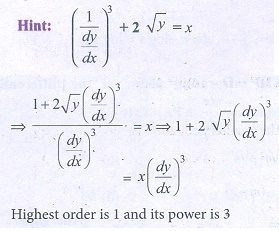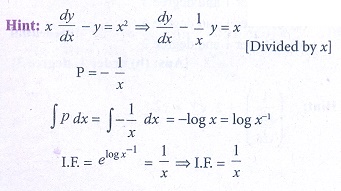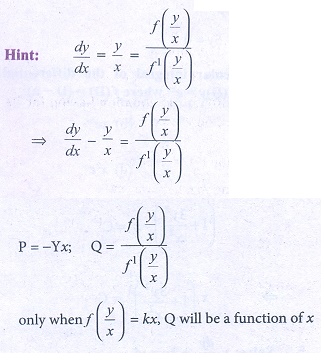Differential Equations - Choose the Correct answer | 12th Business Maths and Statistics : Chapter 4 : Differential Equations
Chapter: 12th Business Maths and Statistics : Chapter 4 : Differential Equations
Choose the Correct answer
Choose the Correct answer
1. The degree of the differential equation 
(a) 1
(b) 2
(c) 3
(d) 4

2. The order and degree of the differential equation  are respectively
are respectively
(a) 2 and 3
(b) 3 and 2
(c) 2 and 1
(d) 2 and 2

3. The order and degree of the differential equation  are respectively.
are respectively.
(a) 2 and 6
(b) 3 and 6
(c) 1 and 4
(d) 2 and 4

4. The differential equation  is
is
(a) of order 2 and degree 1
(b) of order 1 and degree 3
(c) of order 1 and degree 6
(d) of order 1 and degree 2

5. The differential equation formed by eliminating a and b from y = aex + be−x is

Ans: (a)

6. If y = cx + c − c3 then its differential equation is

Ans: (a)

7. The integrating factor of the differential equation dx/dy + Px = Q is
(a) e∫ Pdx
(b) e∫ Pdx
(c) ∫ Pdy
(d) e∫ Pdy

8. The complementary function of ( D2 + 4) y = e2x is
(a) ( Ax + B )e2x
(b) ( Ax + B )e−2x
(c) A cos 2x + B sin 2x
(d) Ae−2 x + Be2x

9. The differential equation of y = mx + c is (m and c are arbitrary constants)
(a) d2y / dx2 = o
(b) y = x dy/dx + c
(c) xdy + ydx = 0
(d) ydx − xdy = 0

10. The particular integral of the differential equation is 

(c) x2e4x
(d) xe4x

11. Solution of dx/dy + Px = 0
(a) x = cepy
(b) x = ce− py
(c) x = py + c
(d) x = cy

12. If sec2x is an integrating factor of the differential equation dy/dx + Py = Q then P =
(a) 2tan x
(b) sec x
(c) cos2x
(d) tan2x

13. The integrating factor of x dy/dx − y = x2 is
(a) -1/x
(b) 1/x
(c) log x
(d) x

14. The solution of the differential equation dy/dx + Py = Q where P and Q are the function of x is dx
(a) y = ∫Qe∫ Pdxdx + c
(b) y = ∫Qe−∫ Pdxdx + c
(c) ye∫ Pdx = ∫Qe∫ Pdxdx + c
(d) ye∫ Pdx = ∫Qe−∫ Pdxdx + C
15. The differential equation formed by eliminating A and B from y = e−2x ( A cos x + B sin x) is
(a) y2 − 4 y1 + 5 = 0
(b) y2+ 4y – 5 = 0
(c) y2 − 4 y1 − 5 = 0
(d) y2 + 4 y1 + 5 = 0

16. The particular integral of the differential equation f ( D) y = eax where f ( D) = ( D − a)2
(a) x2/2 eax
(b) xeax
(c) x/2 eax
(d) x2eax

17. The differential equation of x2 + y2 = a2
(a) xdy+ydx=0
(b) ydx–xdy=0
(c) xdx–ydx=0
(d) xdx+ydy=0

18. The complementary function of  is
is
(a) A + Bex
(b) ( A + B)ex
(c) ( Ax + B )ex
(d) Aex + B

19. The P.I of (3D2 + D − 14)y = 13e2x is
(a) x/2 e2x
(b) xe2x
(c) x2/2 e2x
(d) 13xe2x

20. The general solution of the differential equation dy/dx = cos x is
(a) y = sin x + 1
(b) y = sin x - 2
(c) y = cos x + c , c is an arbitrary constant
(d) y = sin x + c, c is an arbitrary constant

21. A homogeneous differential equation of the form dy/ dx = f (y/x) can be solved by making substitution,
(a) y = v x
(b) v = y x
(c) x = v y
(d) x = v
22. A homogeneous differential equation of the form dx/ dy = f (x/y) can be solved by making substitution,
(a) x = v y
(b) y = v x
(c) y = v
(d) x = v
23. The variable separable form of  by taking y = vx and
by taking y = vx and  is
is

Ans: (d)

24. Which of the following is the homogeneous differential equation?
(a) ( 3x − 5) dx = ( 4 y − 1) dy
(b) xydx - (x3 + y3) dy=0
(c) y2 dx + ( x2 − xy − y2 ) dy = 0
(d) (x2 + y) dx = (y2 + x)dy

25. The solution of the differential equation  is
is

Ans: (a)


Related Topics